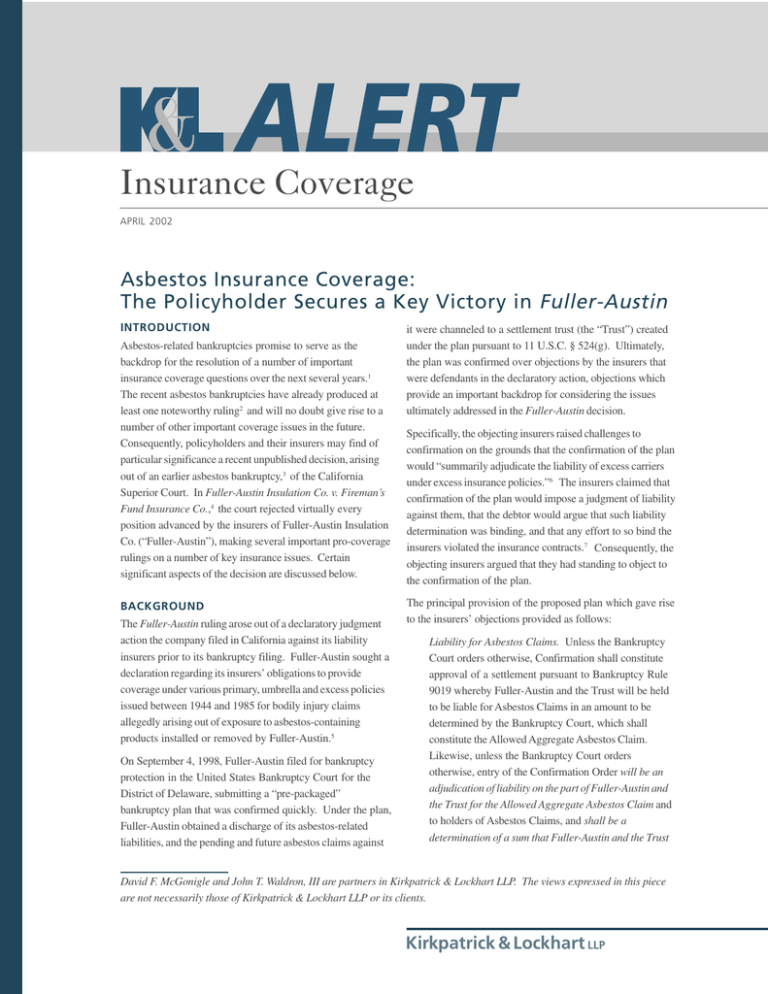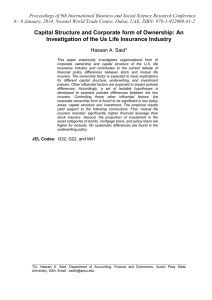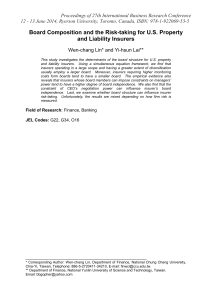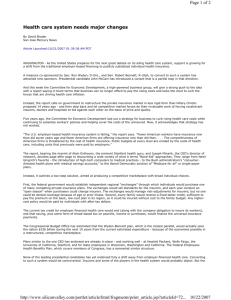
Insurance Coverage
APRIL 2002
Asbestos Insurance Coverage:
The Policyholder Secures a Key Victory in Fuller-Austin
INTRODUCTION
Asbestos-related bankruptcies promise to serve as the
backdrop for the resolution of a number of important
insurance coverage questions over the next several years.1
The recent asbestos bankruptcies have already produced at
least one noteworthy ruling2 and will no doubt give rise to a
number of other important coverage issues in the future.
Consequently, policyholders and their insurers may find of
particular significance a recent unpublished decision, arising
out of an earlier asbestos bankruptcy,3 of the California
Superior Court. In Fuller-Austin Insulation Co. v. Fireman’s
Fund Insurance Co.,4 the court rejected virtually every
position advanced by the insurers of Fuller-Austin Insulation
Co. (“Fuller-Austin”), making several important pro-coverage
rulings on a number of key insurance issues. Certain
significant aspects of the decision are discussed below.
BACKGROUND
The Fuller-Austin ruling arose out of a declaratory judgment
action the company filed in California against its liability
insurers prior to its bankruptcy filing. Fuller-Austin sought a
declaration regarding its insurers’ obligations to provide
coverage under various primary, umbrella and excess policies
issued between 1944 and 1985 for bodily injury claims
allegedly arising out of exposure to asbestos-containing
products installed or removed by Fuller-Austin.5
On September 4, 1998, Fuller-Austin filed for bankruptcy
protection in the United States Bankruptcy Court for the
District of Delaware, submitting a “pre-packaged”
bankruptcy plan that was confirmed quickly. Under the plan,
Fuller-Austin obtained a discharge of its asbestos-related
liabilities, and the pending and future asbestos claims against
it were channeled to a settlement trust (the “Trust”) created
under the plan pursuant to 11 U.S.C. § 524(g). Ultimately,
the plan was confirmed over objections by the insurers that
were defendants in the declaratory action, objections which
provide an important backdrop for considering the issues
ultimately addressed in the Fuller-Austin decision.
Specifically, the objecting insurers raised challenges to
confirmation on the grounds that the confirmation of the plan
would “summarily adjudicate the liability of excess carriers
under excess insurance policies.”6 The insurers claimed that
confirmation of the plan would impose a judgment of liability
against them, that the debtor would argue that such liability
determination was binding, and that any effort to so bind the
insurers violated the insurance contracts.7 Consequently, the
objecting insurers argued that they had standing to object to
the confirmation of the plan.
The principal provision of the proposed plan which gave rise
to the insurers’ objections provided as follows:
Liability for Asbestos Claims. Unless the Bankruptcy
Court orders otherwise, Confirmation shall constitute
approval of a settlement pursuant to Bankruptcy Rule
9019 whereby Fuller-Austin and the Trust will be held
to be liable for Asbestos Claims in an amount to be
determined by the Bankruptcy Court, which shall
constitute the Allowed Aggregate Asbestos Claim.
Likewise, unless the Bankruptcy Court orders
otherwise, entry of the Confirmation Order will be an
adjudication of liability on the part of Fuller-Austin and
the Trust for the Allowed Aggregate Asbestos Claim and
to holders of Asbestos Claims, and shall be a
determination of a sum that Fuller-Austin and the Trust
David F. McGonigle and John T. Waldron, III are partners in Kirkpatrick & Lockhart LLP. The views expressed in this piece
are not necessarily those of Kirkpatrick & Lockhart LLP or its clients.
Kirkpatrick & Lockhart LLP
shall be legally obligated to pay, in the same amount.
Furthermore, unless the Bankruptcy Court orders
otherwise, an Asbestos Claim that is Allowed shall
constitute a judgment of liability against Fuller-Austin
and the Trust shall be legally obligated to pay.8
In addition, the plan had provisions with respect to
preservation of insurance claims that made clear that the
Trust would be the successor to Fuller-Austin in pursuing
insurance recoveries and would be similarly liable for the
asbestos claims, and contained a provision stating that only
the Trust could file objections to asbestos claims after the
effective date of the plan.9 After objections from the
insurers, the debtor ultimately amended the proposed plan of
reorganization. That amendment eliminated the concept of an
“Allowed Aggregate Asbestos Claim” (as addressed above)
and added a new provision that provided for the maintenance
of the California coverage litigation and adjudication of the
claims and defenses of the objecting insurers in that action.10
In reliance on this amendment, the Court concluded that the
rights of the objecting insurers were preserved for
adjudication in the coverage litigation, and therefore ruled that
the insurers did not have standing to object to confirmation of
the plan.11
DISCUSSION
The Effect of Plan Confirmation:
Fuller-Austin Follows UNR
As demonstrated by the discussion above regarding the
battles between Fuller-Austin and certain of its insurers at
plan confirmation, one of the most important issues facing the
California court in that coverage litigation was whether the
confirmation of Fuller-Austin’s bankruptcy plan constituted
a judgment or settlement that would give rise to the insurers’
coverage obligations. Fuller-Austin contended that the
confirmation of its plan did constitute a judgment resolving its
asbestos liabilities, and hence that the insurers were required
to provide coverage immediately for the full amount of the
asbestos liabilities resolved by the plan’s confirmation. The
insurers argued that confirmation of the plan did not affect
their obligations under the policies and that they would be
required to provide coverage, if ever, only upon payment by
Fuller-Austin to individual asbestos claimants. The insurers
further asserted that the plan could not constitute a judgment
because there was no “actual trial” of Fuller-Austin’s asbestos
liabilities, and the plan did not constitute a settlement giving
rise to their obligations because their consent to such a
settlement was, according to the insurers, a prerequisite to
coverage based on the “no action” condition contained in the
policies.
The Court rejected the insurers’ positions, concluding that the
confirmation of Fuller-Austin’s bankruptcy plan did
constitute a judgment that gave rise to the insurers’
obligations. The Court noted that Fuller-Austin had put its
carriers on notice that it would entertain global settlement
negotiations with representatives of the present and future
asbestos claimants in an attempt to reach a consensual
bankruptcy plan resolving those liabilities and that FullerAustin had provided notice to the insurers of its bankruptcy
plan and the related hearings. At the confirmation hearings,
the bankruptcy court was required to assess the proposed
plan to determine whether it was proposed in good faith and
was not collusive. As such, the confirmation hearings
satisfied the requirement in the “no action” clause of an
“actual trial.”12
Following the decision in UNR Industries, Inc. v. Continental
Insurance Co.,13 the Court concluded that the insurers are
required to provide coverage for the full amount of the
liability imposed on Fuller-Austin as a result of plan
confirmation. The Court rejected the insurers’ argument that
they were liable only for the amounts actually paid by FullerAustin and instead found that the insurers were liable for the
full amount of Fuller-Austin’s liability.14
OTHER IMPORTANT COVERAGE RULINGS
In addition to its ruling relating to the effect of the
confirmation of Fuller-Austin’s bankruptcy plan, the Court
made several decisions on insurance issues that may be of
interest to policyholders and insurers outside the context of
bankruptcy-related cases.
For instance, the Court made a significant ruling regarding the
trigger of coverage applicable under Louisiana15 law in the
context of asbestos bodily injury claims. Prior to FullerAustin, the seminal decision on the trigger of coverage under
Louisiana law in the context of asbestos bodily injury claims
was Cole v. Celotex Corp.16 In Cole, the Louisiana Supreme
Court applied the “exposure” trigger theory in a dispute
regarding coverage for asbestos bodily injury claims. The
Louisiana Supreme Court though, as noted in a concurring
opinion in Cole, had not been required in that case to resolve
whether the continuous trigger theory may be applied.
Echoing that concurring opinion, the Court in Fuller-Austin
held that, because it would “fulfill Louisiana’s stated policy
of maximizing insurance coverage under the circumstances
presented by Fuller-Austin,” a continuous trigger of coverage
applied to the policies governed by Louisiana law.17
Because application of the continuous trigger of coverage
would result in the triggering of multiple policies, the Court in
Fuller-Austin was required to address the extent to which
each policy was obligated to respond. Adopting the propolicyholder approach to the allocation of coverage, the Court
held:
Each triggered policy has an independent obligation to
pay in full up to policy limits any indemnity costs on an
asbestos bodily injury claim and, if the policy contains a
defense obligation, to pay in full any defense costs on
the claim. Fuller-Austin is not required to share in the
indemnity or defense costs of a claim based upon any
uninsured or self-insured periods of time.18
The Court also rejected the insurers’ argument that there
should be “horizontal exhaustion” or exhaustion of all
primary insurance before excess insurance could be accessed.
In so doing, the Court distinguished “underlying insurance,”
which determines the attachment point of excess insurance,
from “other insurance,” which relates to a condition contained
in Fuller-Austin’s policies that governs contribution between
insurers:
In contrast to “other insurance,” “underlying insurance,”
which is also defined within all applicable policies, sets
the minimum attachment point that must be reached
before that specific policy must respond. “Underlying
insurance” refers only to the insurance identified in a
specific policy as being specifically under that excess
policy . . . . Accordingly, by definition, “underlying
insurance” cannot include insurance policies issued in
other policy periods. [The insurers’] attempt to expand
the definition of “underlying insurance” to embrace all
policies at lower levels or layers of coverage in all years
does not comport with the language of the policies and is
inconsistent with the case law [which] consistently
distinguishes “underlying insurance” from “other
insurance.”19
The Court issued somewhat inconsistent rulings as to
whether or not a solvent excess insurer is obligated to “drop
down” to the extent that an underlying insurer is insolvent.
On the one hand, the Court seemed to order such drop down,
stating that “an excess insurance policy responds once the
loss exceeds the available solvent coverage at lower layers.”20
However, the Court then noted that Fuller-Austin “is not
seeking to have any of the insurance companies ‘drop down’
below their stated attachment points and fill a gap caused by
the insolvency of an underlying insurance company” and
hence that, “the Court finds that, in accordance with its
rulings on horizontal exhaustion/allocation and the impact of
insolvencies, no excess insurance company is being required
to ‘drop down,’ below its stated attachment point.”21
CONCLUSION
In summary, the Fuller-Austin decision is significant for
policyholders either who themselves have filed, or whose coinsureds have filed, for bankruptcy protection as a result of
asbestos-related liabilities. By following the Seventh Circuit’s
UNR decision, Fuller-Austin may be cited by debtor-
policyholders who seek to require insurers immediately to
provide coverage for the full amount of their asbestos
liabilities at the time of plan confirmation. Because of the
importance of this issue, the recent asbestos-related
bankruptcies are likely to give rise to further rulings on the
effect of plan confirmation. Furthermore, the Fuller-Austin
decision may generally be of interest to those involved in
coverage litigation in connection with asbestos-related
liabilities.
DAVID F. MCGONIGLE
JOHN T. WALDRON, III
The Insurance Coverage practice group at Kirkpatrick &
Lockhart Nicholson Graham LLP offers an international
policyholder-oriented practice on behalf of Fortune 500
and numerous other policyholder clients. Its lawyers have
authored Policyholder’s Guide to the Law of Insurance
Coverage and edited the Journal of Insurance Coverage.
For further information, please consult our website at
www.klng.com.
For additional information concerning this topic or
Kirkpatrick & Lockhart LLP’s insurance coverage practice,
please consult the Kirkpatrick & Lockhart LLP office
contacts listed below:
Boston
John M. Edwards
617.261.3123
jedwards@kl.com
Dallas
Robert Everett Wolin 214.939.4909
rwolin@kl.com
Harrisburg
Raymond P. Pepe
717.231.5988
rpepe@kl.com
Los Angeles
David P. Schack
310.552.5061
dschack@kl.com
Miami
Daniel A. Casey
305.539.3324
dcasey@kl.com
Newark
Anthony La Rocco
973.848.4014
alarocco@kl.com
New York
Eugene R. Licker
212.536.3916
elicker@kl.com
Pittsburgh
David F. McGonigle 412.355.6233
Thomas M. Reiter
412.355.8274
John T. Waldron, III 412.355.8314
dmcgonigle@kl.com
treiter@kl.com
jwaldron@kl.com
San Francisco
Edward Sangster
415.249.1028
esangster@kl.com
Washington
Matthew L. Jacobs
202.778.9393
mjacobs@kl.com
ENDNOTES
11 Id. at *3.
1
12 Statement of Decision at *20-22. Because the Court found the
2
The roster of recent asbestos bankruptcy filings is substantial,
including at least a dozen separate filings in the past two
years: In re: Babcock and Wilcox Co., No. 00-1099-2 (Bankr.
confirmation of the bankruptcy plan to constitute an adjudication, it concluded that the issue of whether or not the insurers
E.D. La. 2000); In re: Pittsburgh Corning Corp., No. 80-22876
(Bankr. W.D. Pa. 2000); In re: Owens Corning Corp., Nos. 00-
had consented to the plan pursuant to the “no action” conditions
in their policies to be “moot.” The Court noted though that,
3837, 00-3854 (Bankr. D. Del. 2000); In re: Armstrong World
Industries, Inc., No. 00-044471 (Bankr. D. Del. 2000); In re: G-I
even if the confirmation of the plan constituted a settlement
rather than a judgment, the “no action” clause was satisfied
Holdings, Inc., No. 01-30135 (Bankr. D.N.J. 2001); In re: W.R.
Grace & Co., Nos. 01-1139, 01-1140 (Bankr. D. Del. 2001); In re:
United States Gypsum Co., No. 01-02095 (Bankr. D. Del. 2001);
In re: Federal-Mogul Corp., No. 01-10582 (Bankr. D. Del. 2001);
In re: U.S. Mineral Products Co., No. 01-2471 (Bankr. D. Del.
2001); In re: Kaiser Aluminum, No. 02-10429 (Bankr. D. Del.
2002); In re: North American Refractories Co., No. 02-20198
(Bankr. W.D. Pa.); and In re: Global Industrial Technologies,
Inc., et al., No. 02-21626 (Bankr. W.D. Pa.).
because Fuller-Austin had taken sufficient steps to permit the
insurers to participate in the negotiations and proceedings
In re: Fuller-Austin Insulation Co., No. 98-02038 (Bankr. D. Del.).
4
Fuller-Austin Insulation Co. v. Fireman’s Fund Ins. Co., 2002 WL
398672, No. BC 116835, Statement of Decision as to Phase IB,
Issues 2-7 and 9 (Cal. Super. Ct., Feb. 26, 2002) (hereinafter,
“Statement of Decision”).
14 As referenced above, unlike UNR, in which the aggregate value
of the asbestos claims (both present and future) had been
determined in the bankruptcy proceedings with that determination binding UNR’s insurers, the parties in Fuller-Austin had
agreed that the valuation of Fuller-Austin’s asbestos claims
would be preserved and presented to a jury for determination.
Thus, in a subsequent phase of the case, Fuller-Austin will be
entitled to present evidence to a jury regarding the amount of
its liability to present and future claimants. In this regard,
the Court found that Fuller-Austin’s experts, Dr. Peterson and
Dr. Florence, qualified as experts and that their testimony and
methodologies in valuing asbestos liabilities were admissible:
“The ability to calculate present and future asbestos liabilities
and the methodologies employed by Fuller-Austin’s experts, Dr.
Peterson and Dr. Florence, have been recognized in published
opinions.” Statement of Decision, at *26.
15 Certain of the policies at issue in Fuller-Austin were governed
by Louisiana law while others were governed by California law.
The parties stipulated to the use of the continuous trigger of
coverage for those policies governed by California law.
During the pendency of the case, Fuller-Austin settled with all
of its primary insurers and certain of its umbrella and excess
insurers.
6
13 UNR Indus., Inc. v. Continental Ins. Co., 942 F.2d 1101 (7th Cir.
1991).
Certain Underwriters at Lloyd’s, et al. v. Babcock & Wilcox Co.,
Nos. 01-0912 and 01-1187, 2002 U.S. Dist. LEXIS 874 (E.D. La.
Jan. 4, 2002) (granting policyholders’ motions for summary
judgment and ruling, inter alia, that The Babcock & Wilcox
Company did not materially breach or anticipatorily breach its
coverage-in-place agreement with the London insurers by
submitting a proposed plan of reorganization that contemplated the possible assignment of the agreement to a claimshandling trust). (Kirkpatrick & Lockhart LLP represented The
Babcock & Wilcox Company in the case.)
3
5
leading up to confirmation of its bankruptcy plan. Id. at *23.
In re: Fuller-Austin Insulation, 1999 WL 812388, at *1 (quoting
objections to approval of the disclosure statement and
confirmation of the plan filed by insurers).
16 Cole v. Celotex Corp., 599 So. 2d 1058 (La. 1992).
17 Statement of Decision, at *7.
18 Id. at *8.
19 Id. at *9 (citations omitted; emphasis in original).
7
Id.
20 Id. at *10 (emphasis added).
8
Id. at *2 (emphasis in original).
21 Id.
9
Id. at *2.
10 The provision provided as follows:
Maintenance of the Coverage Litigation. Notwithstanding any
other provision in this Plan, all claims and defenses of any
Asbestos Insurance Company that is a party to the Coverage
Litigation shall be adjudicated in the Coverage Litigation, and
all rights of the Asbestos Insurance Companies under the
Asbestos Insurance Policies shall remain unaffected by the Plan
and the Confirmation Order.
Id. (emphasis in original).
®
Kirkpatrick & Lockhart LLP
Challenge us. ®
www.kl.com
BOSTON
■
DALLAS
■
HARRISBURG
■
LOS ANGELES
■
MIAMI
■
NEWARK
■
NEW YORK
■
PITTSBURGH
■
SAN FRANCISCO
■
WASHINGTON
.........................................................................................................................................................
This publication/newsletter is for informational purposes and does not contain or convey legal advice. The information herein
should not be used or relied upon in regard to any particular facts or circumstances without first consulting a lawyer.
© 2002 KIRKPATRICK & LOCKHART LLP.
ALL RIGHTS RESERVED.





